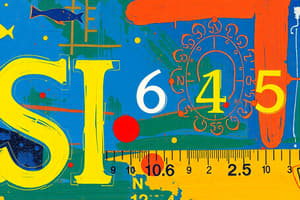Podcast
Questions and Answers
What is the primary difference between fundamental and derived units?
What is the primary difference between fundamental and derived units?
- Fundamental units are used for measurements in physics, while derived units are only used in chemistry. (correct)
- Fundamental units can be expressed in terms of each other, whereas derived units cannot.
- Fundamental units are defined by physical constants while derived units are based on experimental measurements.
- Fundamental units are independent and cannot be further broken down, while derived units are formed from these fundamental units.
Which statement accurately reflects the concept of uncertainty in measurement?
Which statement accurately reflects the concept of uncertainty in measurement?
- Uncertainty can be eliminated completely with advanced technology.
- Uncertainty represents the doubt about the measurement's accuracy due to various factors. (correct)
- Uncertainty is always zero in precise measurements.
- Uncertainty can be calculated using only the average value of multiple measurements.
What role do SI prefixes play in scientific measurements?
What role do SI prefixes play in scientific measurements?
- They provide a theoretical framework for measurement accuracy.
- They help in converting fundamental units into derived units.
- They standardize measurement units globally.
- They modify units to represent values in powers of ten for ease of representation. (correct)
Which of the following is NOT a source of error in measurements?
Which of the following is NOT a source of error in measurements?
In dimensional analysis, what does the process primarily aim to achieve?
In dimensional analysis, what does the process primarily aim to achieve?
What does a measurement represented as (20.1 ± 0.1) cm signify about the true value?
What does a measurement represented as (20.1 ± 0.1) cm signify about the true value?
Which of the following describes systematic errors?
Which of the following describes systematic errors?
Which source of error is exemplified by a dial instrument that fails to zero properly?
Which source of error is exemplified by a dial instrument that fails to zero properly?
What generally helps to reduce the effect of random errors in measurements?
What generally helps to reduce the effect of random errors in measurements?
Which of the following scenarios represents a random error?
Which of the following scenarios represents a random error?
Flashcards
Physical Quantities
Physical Quantities
Measurable properties of objects or systems, such as length, mass, time, or temperature.
Units of Measurement
Units of Measurement
Standard values used to express the magnitude of physical quantities.
Fundamental Units
Fundamental Units
Base units that are independent and cannot be expressed in terms of other units.
Derived Units
Derived Units
Signup and view all the flashcards
Dimensional Analysis
Dimensional Analysis
Signup and view all the flashcards
Uncertainty in Measurement
Uncertainty in Measurement
Signup and view all the flashcards
Best Estimate
Best Estimate
Signup and view all the flashcards
Systematic Error
Systematic Error
Signup and view all the flashcards
Random Error
Random Error
Signup and view all the flashcards
Reducing Random Error
Reducing Random Error
Signup and view all the flashcards
Study Notes
Physical Quantities and Units of Measurement
- Physical quantities are described by both magnitude and units.
- Units of measurement are standardized magnitudes used for comparisons.
- Measurement involves determining the magnitude of a physical quantity using an instrument.
- Fundamental units are basic units like meters, kilograms, and seconds.
- Derived units are combinations of fundamental units.
- Dimensions represent the physical nature of a quantity.
- Dimensional analysis relates quantities and their dimensions using equations.
SI Prefixes and Scientific Notation
- Scientific notation expresses numbers as a product of a number between 1 and 10 and a power of 10.
- SI prefixes are used to express very large or very small quantities.
Uncertainty in Measurement and Significant Figures
-
Measurements have associated uncertainties due to limitations of instruments and techniques.
-
Uncertainty represents the range of probable values for the true value.
-
Measurements are expressed in the format: (best estimate ± uncertainty) unit.
-
Sources of error include instruments, procedures, and the measured quantity itself.
-
Types of errors include systematic and random errors.
-
Systematic errors consistently bias readings in one direction.
-
Random errors cause unpredictable variations in readings.
-
Averaging multiple measurements reduces the effect of random errors.
-
Significant figures reflect the precision of a measurement.
-
The product or ratio of measurements has the same number of significant figures as the measurement with the fewest significant figures.
Order of Magnitude
- Order of magnitude expresses the approximate size of a quantity as a power of 10.
- It's useful for estimations and comparisons, particularly when accuracy is less critical.
Vectors: Addition, Components, Magnitude, and Direction
- Vectors have both magnitude and direction.
- Examples include force, velocity, and acceleration.
- Vectors can be added/subtracted graphically using the triangle or parallelogram method.
- Vectors are added component-wise.
- Components are scalar quantities representing vector projections along coordinate axes.
- The magnitude of a vector is calculated by the Pythagorean theorem applied to its components.
- The direction of a vector can be determined from its components.
- Vector equality requires both magnitude and direction to be identical when comparing with another vector.
Studying That Suits You
Use AI to generate personalized quizzes and flashcards to suit your learning preferences.




